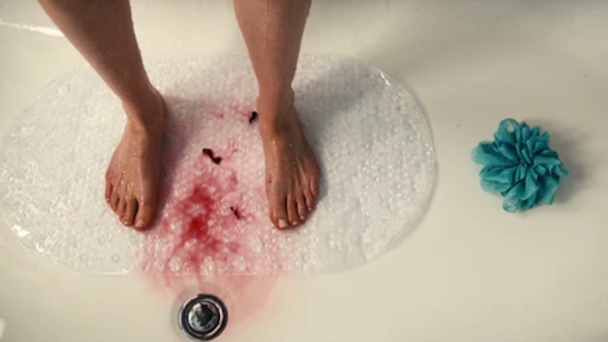300 Brits complained about a period ad showing blood and clots. That’s progress
Margaux Revol, strategy partner and head of brand at AMV BBDO, was at the cutting edge of breaking the period taboo in advertising but half a decade later, people are still complaining about them. She reflects.

Last week a Wuka ad received 300 complaints for showing period blood and clots in the shower. They claimed the imagery was “offensive and distressing”. It was exciting to see the ASA dismiss those complaints to keep the ad running.
In 2017, when we launched Bloodnormal for Bodyform in the UK (and Libresse globally), the world was very different. Because we wanted to visual blood, we were originally not allowed to run on TV in the UK or France and had to fight extremely hard even to launch it online - I’m talking months and months of process, not a few hurdles. Hence our rally cry: ‘Periods are normal. Showing them should be too'.
The controversy was such that Bloodnormal ended up being discussed and shown literally everywhere, including on TV programs discussing it, as it was such a revolutionary thing to finally show periods for what they were.
Bloodnormal made such a big red splash that it had ripple effects everywhere - in the category, industry, and culture. It’s pushed all the competitors to eventually adopt red liquid, the industry to revisit how we portray women’s bodies or express their wants and needs, it’s created a wave of positive period representations, it’s been quoted in books, and it’s been the main subject of quite a few students and researchers in the academic world...
Advertisement
Because of all this, it might seem difficult to imagine that seven years ago, we were made to think we were crazy to even imagine showing red blood, period blood in the shower, or a bloody pad in a woman’s underwear.
We were made to doubt ourselves, but we were hanging on to that dream that maybe, several years later, the sight of period blood would be so normalized that nobody would actually believe it was even “a thing” to have to fight for it. We had ironically made normality revolutionary.
It became really encouraging when, as a result of all the waves we were making, broadcasters started overturning the bans everywhere: In fact, when Bloodnormal was launched by Libra (sister Essity brand) in Australia the following year, it was one of the most complained ads of all times there (more than 600), but the Ad Standards (equivalent of UK ASA) decided to dismiss them.
Since then, there’s been a lot of progress. But it’s not been as straightforward as one would think.
In many respects, taboos follow the same journey as the 'Innovation Adoption Life Cycle'. No one touches them until 'innovators' come to challenge them, followed by 'early adopters.’ Next, come the 'early majority' and the 'late majority'. And finally, the last group is the 'phobics,' who are really averse to what’s happening and struggling to get on board - and in the case of periods, quite literally afraid or struggling with the reality of menstruation.
Advertisement
And like for most innovations, “the process is complex and multi-stage.”
It’s not just about one person or one brand thinking it’s the right thing to do; it really comes down to society’s collective assessment of whether this is beneficial or not. And to do that, it means not only shouting or using shock tactics, it also means portraying it in such a creative, beautiful, expressive way that people overcome the shame and discomfort. It can switch how the see their periods and their bodies, adopting a reconciled view of themselves - rather than a disgusted view of their fluids and a divorced relationship with their feelings around their bodies.
The other helpful comparison in my mind is the 'Hype Cycle' - After the initial breakthrough, people get excited and have high expectations. Often followed by the 'Trough of Disillusionment or Disappointment'. Those that can keep going are on the 'Slope of Enlightenment', and finally, you can reach a stage where mass adoption is possible and easy. Thinking of the journey on Libresse/Bodyform and the many chapters of Live Fearless, there was so much excitement after Bloodnormal’s success that we naively thought it would be easy to keep going. We thought we had blown open a door that couldn’t be closed again and that media owners would naturally all be ready to keep seeing women’s bodies and periods more authentically. That was not our experience.
Suggested newsletters for you
From Bloodnormal to Viva la Vulva to Wombstories to Let your Body Flow to our latest Periodsomnia, we’ve been showing period blood consistently and in different contexts, but also women’s bodies in ways seldom-seen before. And for this, we’ve always encountered difficulties and censorship across various media platforms, and often assets taken down on social media as automatically picked up as “offensive.”
So things didn’t get that much easier. But we did get better at it. Between agency, global and local brand teams, we’ve kept pushing and defending the work and proving how well it was received by women+: In all our campaigns, we’ve always put women+ and consumers at the heart of it to make sure we really make them feel understood.
So much so that last year, when the ASA received 800 complaints for Bodyform Periodsomnia - (it was the most complained ad of 2022), but dismissed them, it felt like we had reached that tipping point where the authorities might not even need our push any more to defend what’s right for women+ and society at large. And it’s giving society that same message that they should probably get on board, too.
The fact that they are dismissing complaints in 2023 for this Wuka advert confirms that the ASA is now past the tipping point.
And importantly, there were fewer complaints to Wuka than to our film last year makes me hopeful that even among the “phobic,” the fear and shame are diminishing.
Taboos are stubborn. But we can out-stubborn them.
It’s not about shock tactics. It’s about deep listening and creativity that can make people feel seen. And when the majority of people feel finally understood, you make your peace with the fact that some are not quite there yet, and some will always be haters.
I’d like to think that this Blood has indeed become Normal.
[Editor's note: watch the Wuka ad in question below]

